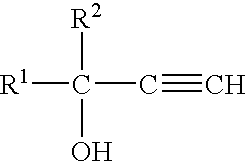Method and compositions for attracting mosquitoes employing (R)-(+)-isomers of 1-alkyn-3-ols
a technology of r-(+)-isomers and compositions, applied in the field of compositions for attracting mosquitoes, can solve the problems of insufficient inability to meet the needs of recent years, and inability to achieve adequate success in search for more effective mosquito attractants, etc., and achieve the effect of superiorly useful compositions
- Summary
- Abstract
- Description
- Claims
- Application Information
AI Technical Summary
Benefits of technology
Problems solved by technology
Method used
Image
Examples
example 1
[0019] The following tests were conducted in Connecticut in September 2004. Mosquito traps model 1012 manufactured by John W. Hock Company in Gainesville, Florida were used in these experiments. The traps use a stream of CO2 directed in the vicinity of a collection bag, with a fan used to blow mosquitoes into the bag. The light supplied with the trap was turned off. The traps were spaced 65-70 feet apart at the edge of a wetland in Danbury, Conn., at least 25 feet from any buildings. The (R) and (S)-1-octyn-3-ol was incorporated into a wax lure of the type manufactured by BioSensory, Inc. and placed near a stream of CO2 which was being released at a rate of approximately 140 ml / minute. The traps were operated from approximately 4:00 PM until 9:00 AM the next day. Daytime temperatures were 70-75° F. during the trials. Average weight loss from the wax lures during the test was approximately 4 mg / day, or 0.17 mg / hr. Three traps were used, with either (R)-1-Octyn-3-ol, (S)-1-Octyn-3-ol,...
example 2
[0021] Tests were conducted with the Mosquito Magnet Liberty model manufactured by American Biophysics Corp. The traps were spaced 65-70 feet apart at the edge of a wetland in Danbury, Conn., at least 25 feet from any buildings. 1 gram of test chemical was added to a clean porous frit of the type normally used in the trap, releasing approximately 1 mg / h. (R)-(+)-1-octyn-3-ol, (S)-(-)-1-octyn-3-ol, (R)-(-)-1-octen-3-ol, and racemic 1-octen-3-ol were rotated twice among four traps over eight days, and the results for each attractant were compared.
[0022] The results of these tests were as follows. In this test the trap with the (R)-(+) isomer of 1-octyn-3-ol caught 34% more mosquitoes than the trap with the 50:50 racemic mixture of 1-octen-3-ol, whereas the trap with the (S)-(−) isomer of 1-octyn-3-ol caught 23% less mosquitoes than the trap with the 50:50 racemic mixture of 1-octen-3-ol, again demonstrating the unexpected superior mosquito attracting properties of the (R)-(+) isomer....
example 3
[0023] In tests performed in Florida using Mosquito Magnet Pro units, (R)-(+)-1-octyn-3-ol was compared with racemic 1-octyn-3-ol and (S)-(-)-1-octyn-3-ol at release rates of approximately 60 mg / day and 500 mg / day. The lures were rotated among the traps and compared to the same traps with no lure, all relative to a control trap. The (S)-(-)-1-octyn-3-ol caught an average of 39% more mosquitoes relative to the control than the traps when no lure was used (18 test days), the racemic 1-octyn-3-ol caught an average of 240% more mosquitoes than did no lure (10 test days), and the (R)-(+)-1-octyn-3-ol caught an average of 334% more mosquitoes than the traps with no lure (16 test days).
PUM
| Property | Measurement | Unit |
|---|---|---|
| wt % | aaaaa | aaaaa |
| composition | aaaaa | aaaaa |
| Enantiomeric Purity | aaaaa | aaaaa |
Abstract
Description
Claims
Application Information
 Login to View More
Login to View More - R&D
- Intellectual Property
- Life Sciences
- Materials
- Tech Scout
- Unparalleled Data Quality
- Higher Quality Content
- 60% Fewer Hallucinations
Browse by: Latest US Patents, China's latest patents, Technical Efficacy Thesaurus, Application Domain, Technology Topic, Popular Technical Reports.
© 2025 PatSnap. All rights reserved.Legal|Privacy policy|Modern Slavery Act Transparency Statement|Sitemap|About US| Contact US: help@patsnap.com



